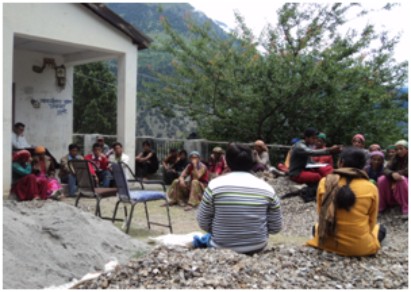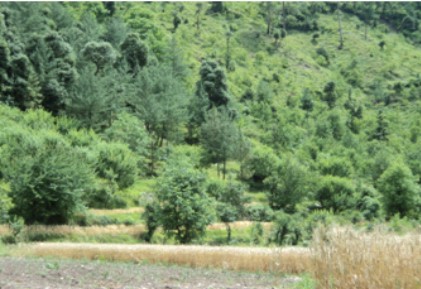|
Agro-Forestry: Changing
Cultivation Patterns
A gro-forestry is defined as any sustainable land use system that maintains or increases total yields by combining food crops (annuals) with tree crops (perennials) and/or livestock on the same unit of land, either alternately or at the same time, using management practices that suit the social and cultural characteristics of the local people and the economic and ecological conditions of the area. Although it is an age-old practice, the concept formally came into existence in India after the recommendations of National Commission on Agriculture (1976), given with the objectives of reducing pressure on forests and significantly increasing rural livelihoods.The Himalayan regions have been
witnessing a continuous decline in
These factors have adversely
affected villagers' livelihood and income generation capacities and
induced stress migration undertaken in search of fodder for the large
livestock population typical of the Upper Himachal Region (UHR). In this
context, the agro-forestry system has provided and can continue to
provide viable solutions which will not only enhance the economy of the
region, but also supplement ecological services in the fragile ecosystem
of the Himalayas.(The agro-forestry systems are being maintained and
encouraged by the state government through a number of flagship
programmes). Farmers have been growing fruit trees such as apple, pomegranate, plum, almond, walnut, seabuckthorn, wild chuli, peach etc. in their agricultural fields along with potatoes, garlic, peas, tomatoes, pulses and cereals like maize, wheat, barley and paddy. Poplars and willows are widely planted by the people on the bunds of the fields even in the difficult and rugged terrain of Kinnaur, Chamba and Lahul Spiti. When poplar and willow are planted on the hedges, both kharif and rabi crops are grown in the fields. These two important agro-forestry species serve as windbreak, reducing soil erosion. Also, they provide fodder and fuelwood to local inhabitants which significantly improves their livelihood prospects and socio-economic condition. CLAP team members often encourage farming communities to adopt sound agro-forestry practices. The people are advised regarding ecological and economic tree species that can be grown in and around the agricultural field. The representatives of Panchyats, SHGs, Mahila Mandals, Yuvak Mandals, etc. miss no opportunity to solicit information from CLAP team members about the ecological and environmental benefits of agro-forestry practices. Existing agro-forestry practices in Traditional Farming Systems (TFS) have gained wider attention among politicians, scientists and policy makers at national and international levels due to the multifunctional role and environmental services of agro-forestry systems. The Convention on Biological Diversity (CBD) has advocated an ecosystem approach while the Intergovernmental Panel on Climate Change (IPCC) has emphasised agro-forestry as a means of sequestering carbon dioxide and reducing GHG emissions (LULUCF, 2001). q Naveen Kumar References http://www.fao.org/forestry/6470-0e476a569c0c19869e4f7e5eb 88ad3d17.pdf Sharma, G. and Dhakal, T.D. opportunities and challenges of the globally important tradition alagriculture heritage systems of the Sikkim Himalaya Source of Photographs: CLAP Programme (HP)
|
 agri-horticulture produce over the
last two decades. The comprehensive assessment of a number of Panchyats
in several districts of Himachal Pradesh under the Community-Led
Assessment, Awareness, Advocacy and Action Programme for Environment
Protection and Carbon Neutrality (CLAP) attributes it largely to shifts
in the monsoon pattern, frequent land sliding, loss of soil nutrients,
excessive use of chemical fertilizers, shifting land use patterns,
shrinking natural springs and lack of irrigation facilities. In order to
address these issues, the Development Alternatives Group has been
conducting a three-year project under CLAP in Himachal Pradesh, funded
by the State of HP. The project seeks to mobilise communities and
panchayats to undertake local-level environmental improvement actions
through a network of eco-clubs, mahila mandals, yuvak mandals and NGOs.
agri-horticulture produce over the
last two decades. The comprehensive assessment of a number of Panchyats
in several districts of Himachal Pradesh under the Community-Led
Assessment, Awareness, Advocacy and Action Programme for Environment
Protection and Carbon Neutrality (CLAP) attributes it largely to shifts
in the monsoon pattern, frequent land sliding, loss of soil nutrients,
excessive use of chemical fertilizers, shifting land use patterns,
shrinking natural springs and lack of irrigation facilities. In order to
address these issues, the Development Alternatives Group has been
conducting a three-year project under CLAP in Himachal Pradesh, funded
by the State of HP. The project seeks to mobilise communities and
panchayats to undertake local-level environmental improvement actions
through a network of eco-clubs, mahila mandals, yuvak mandals and NGOs.